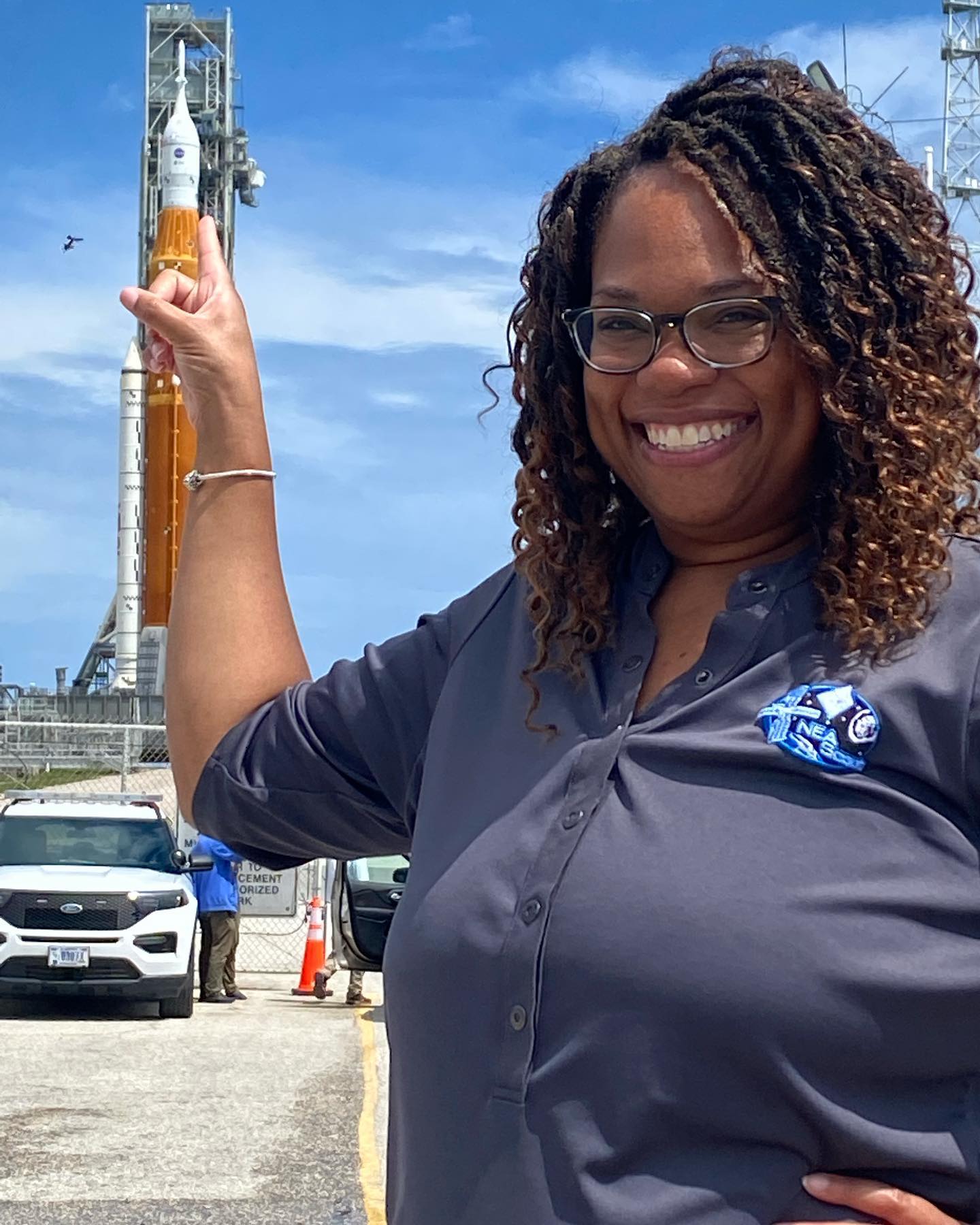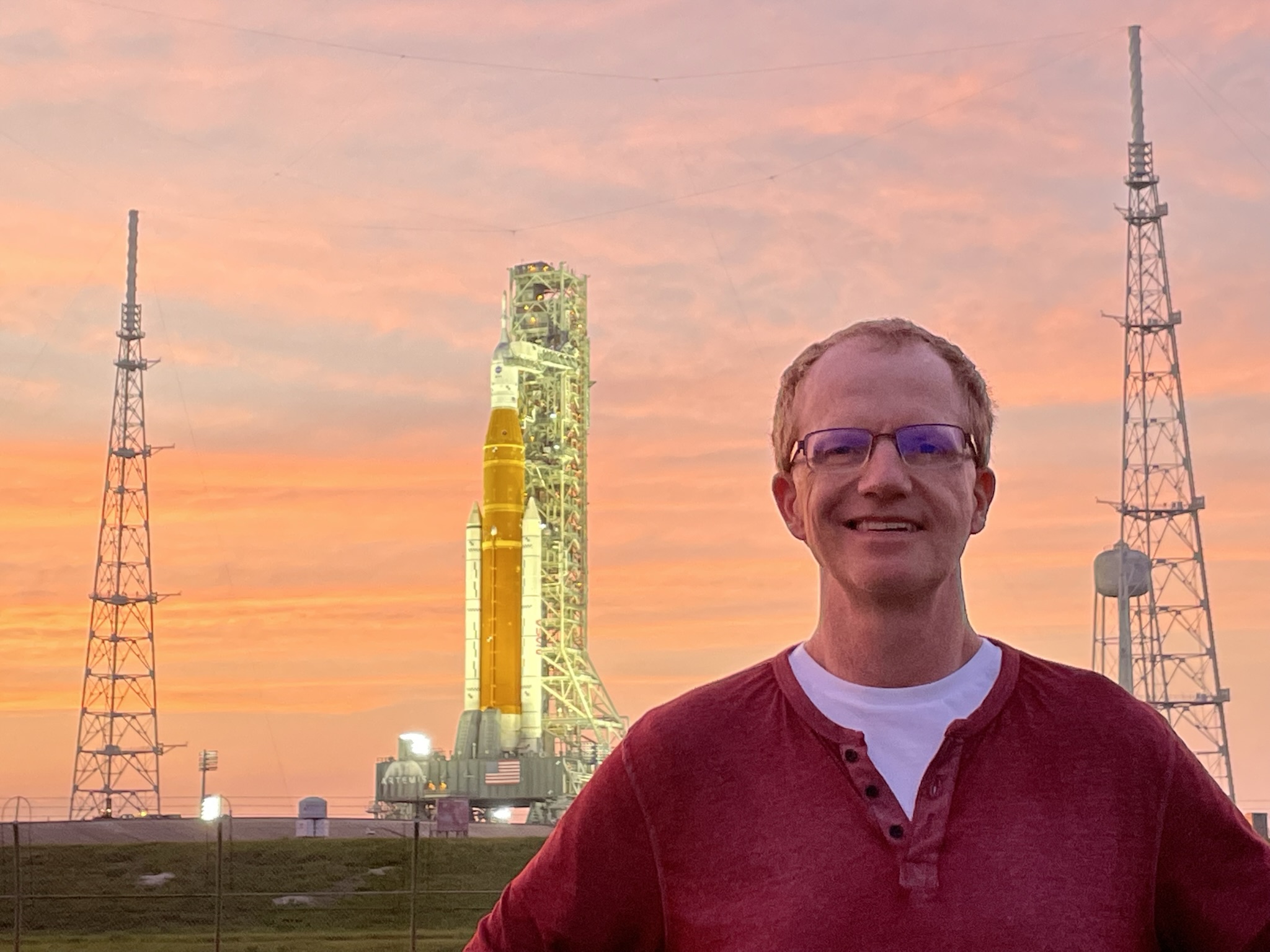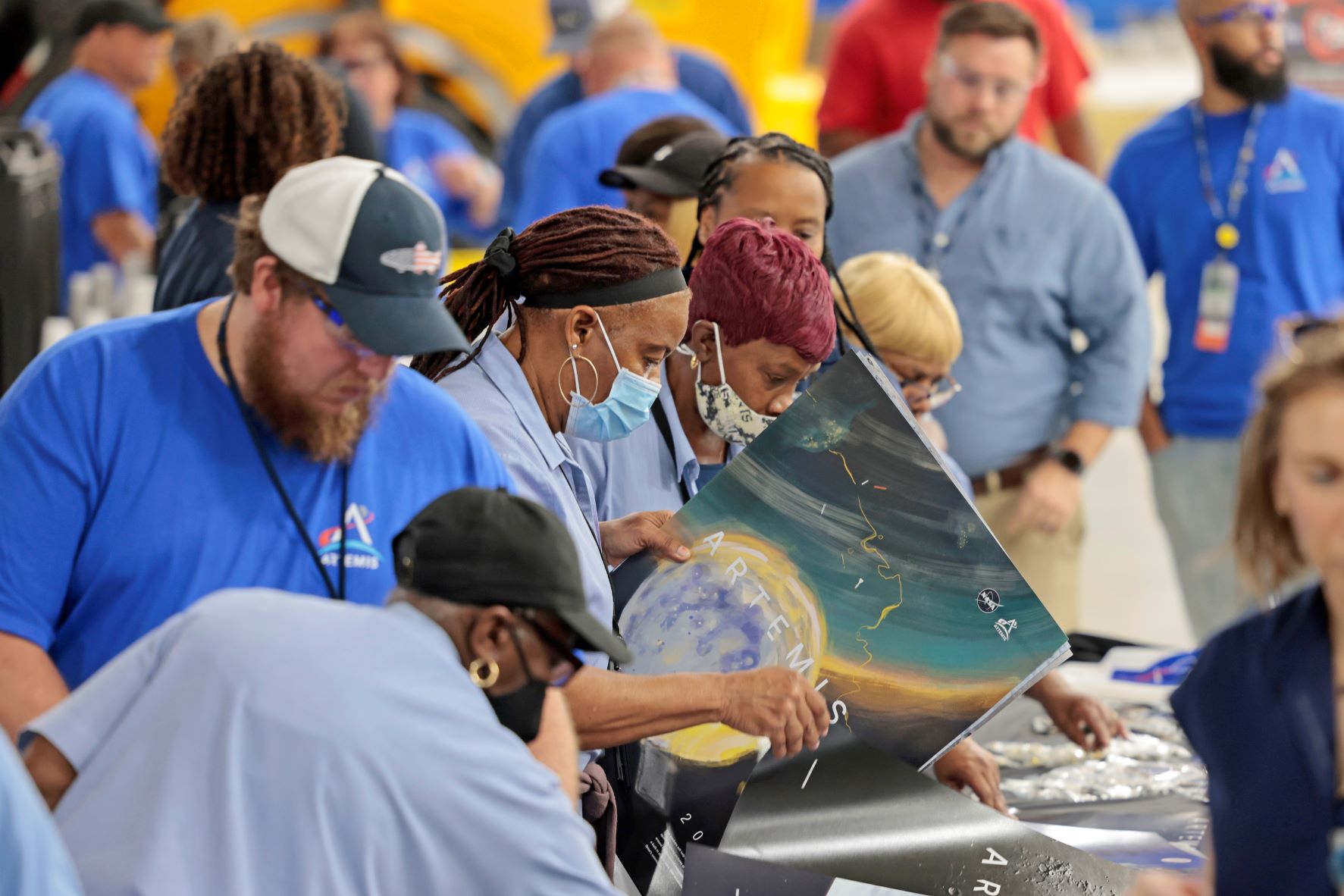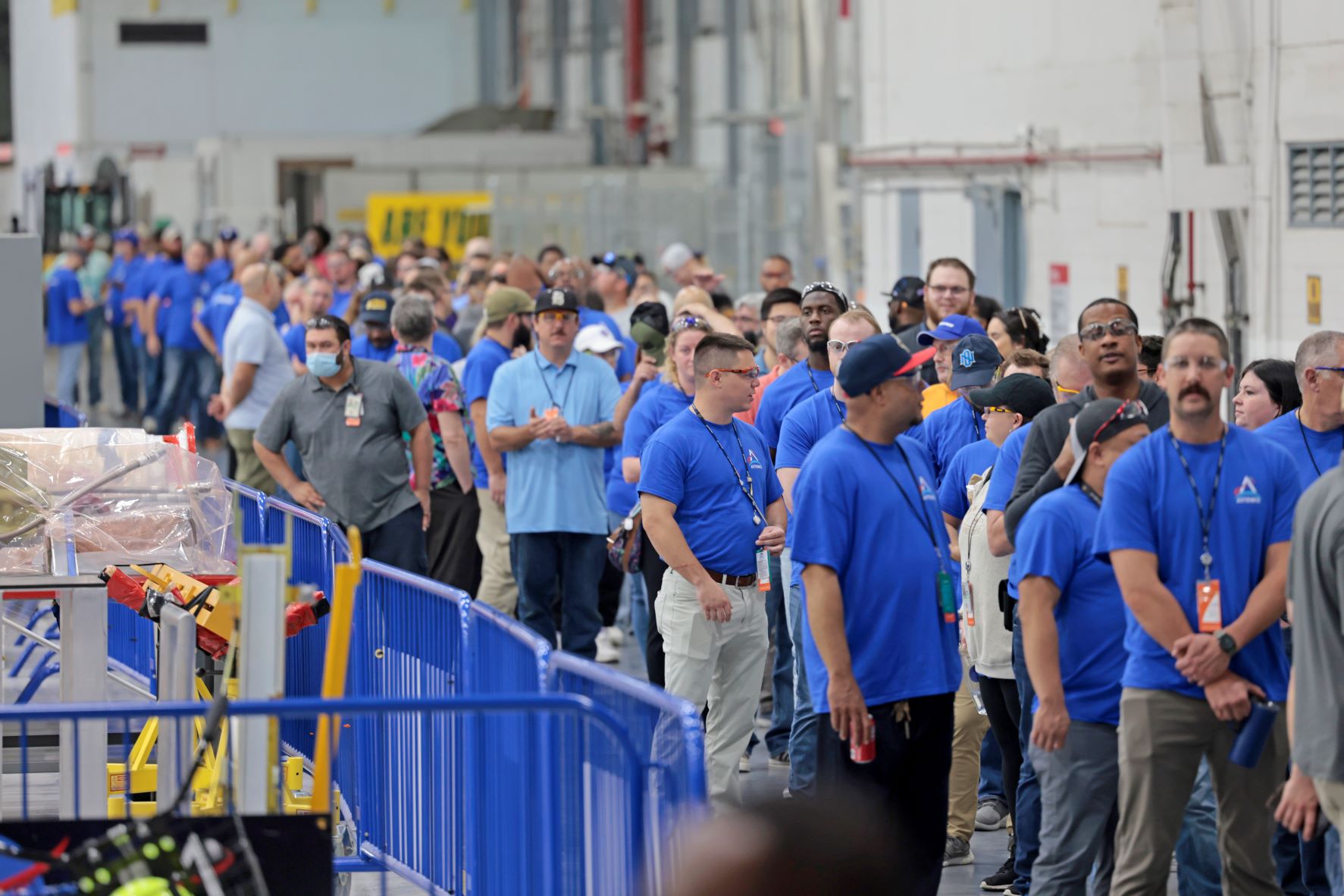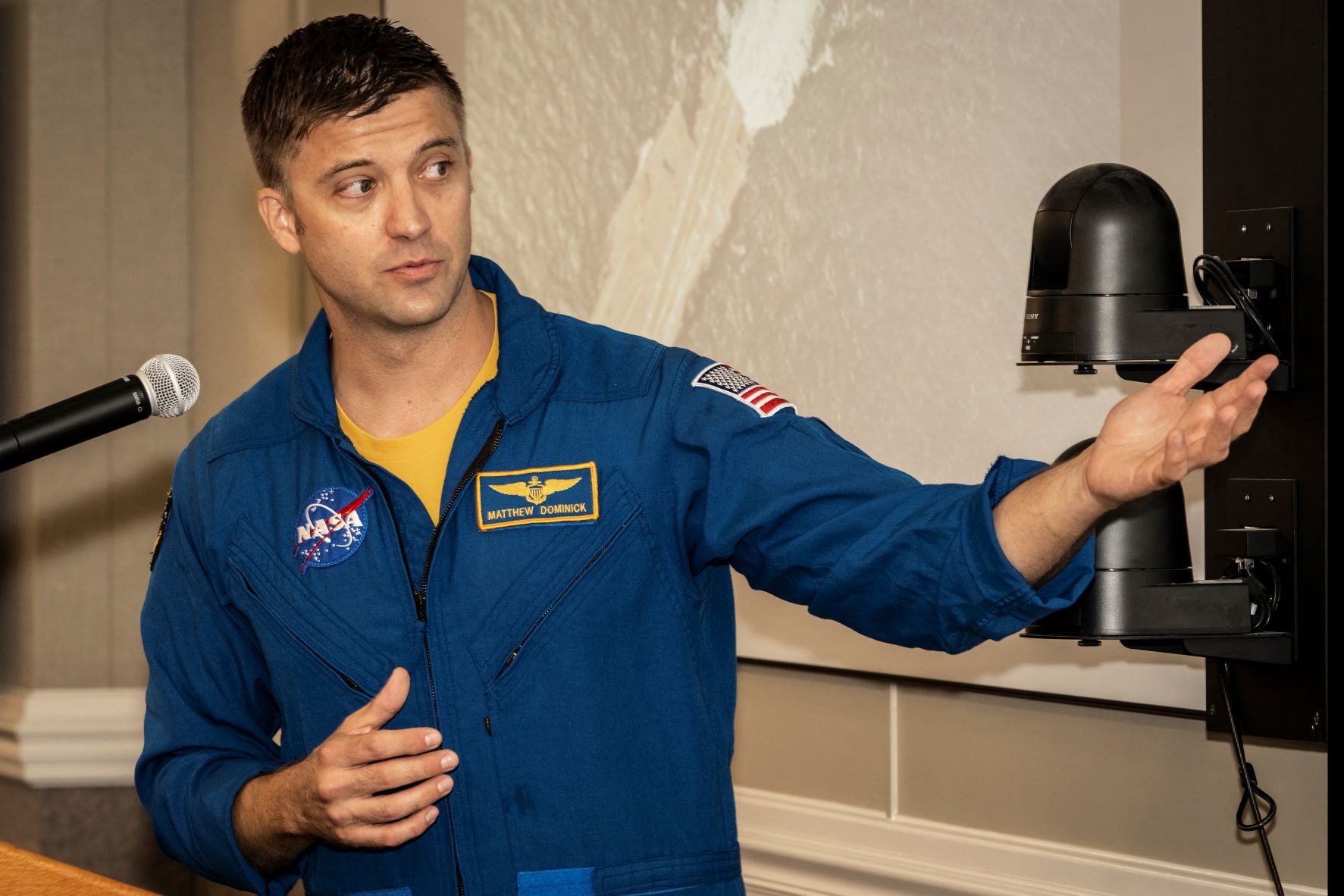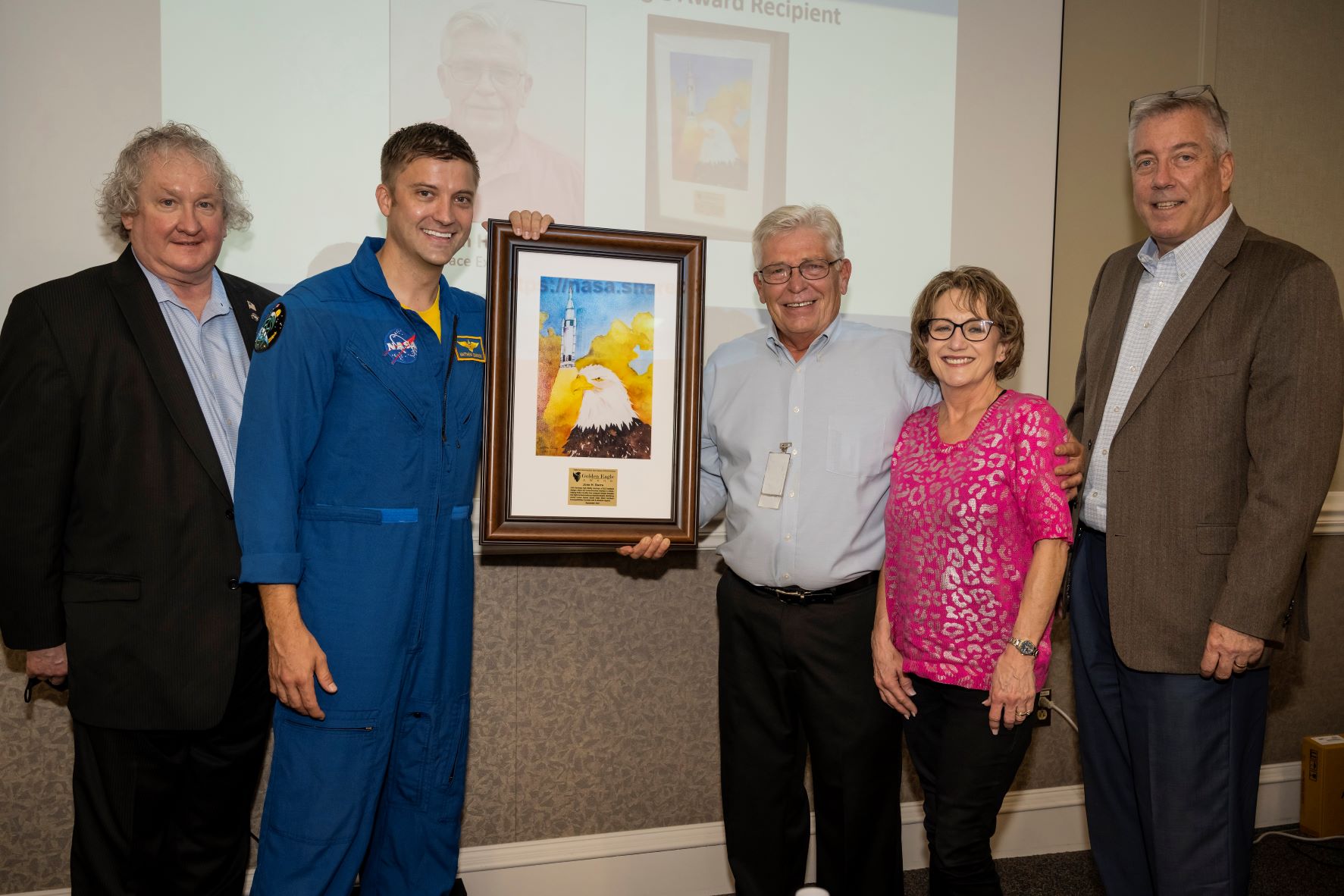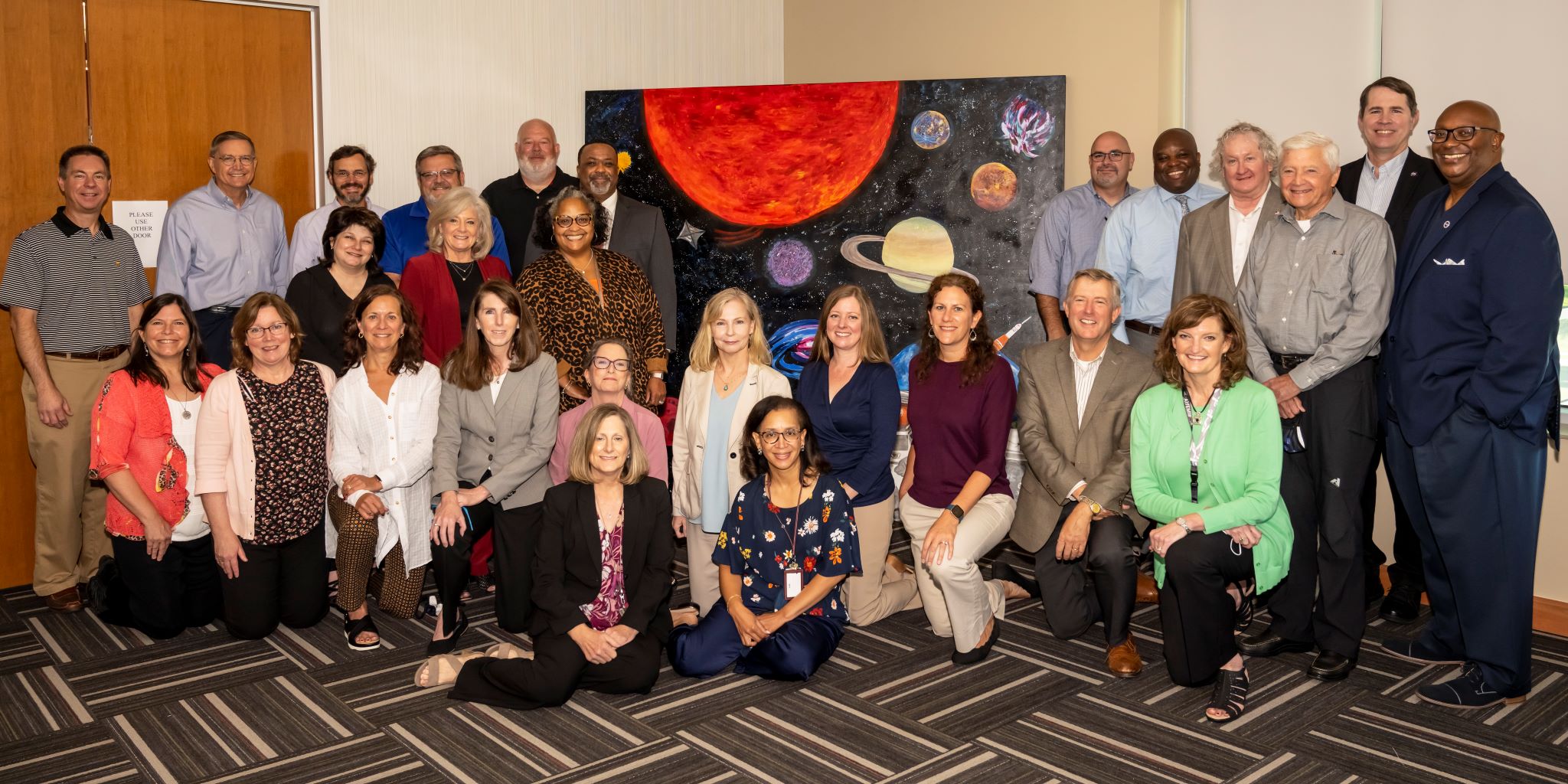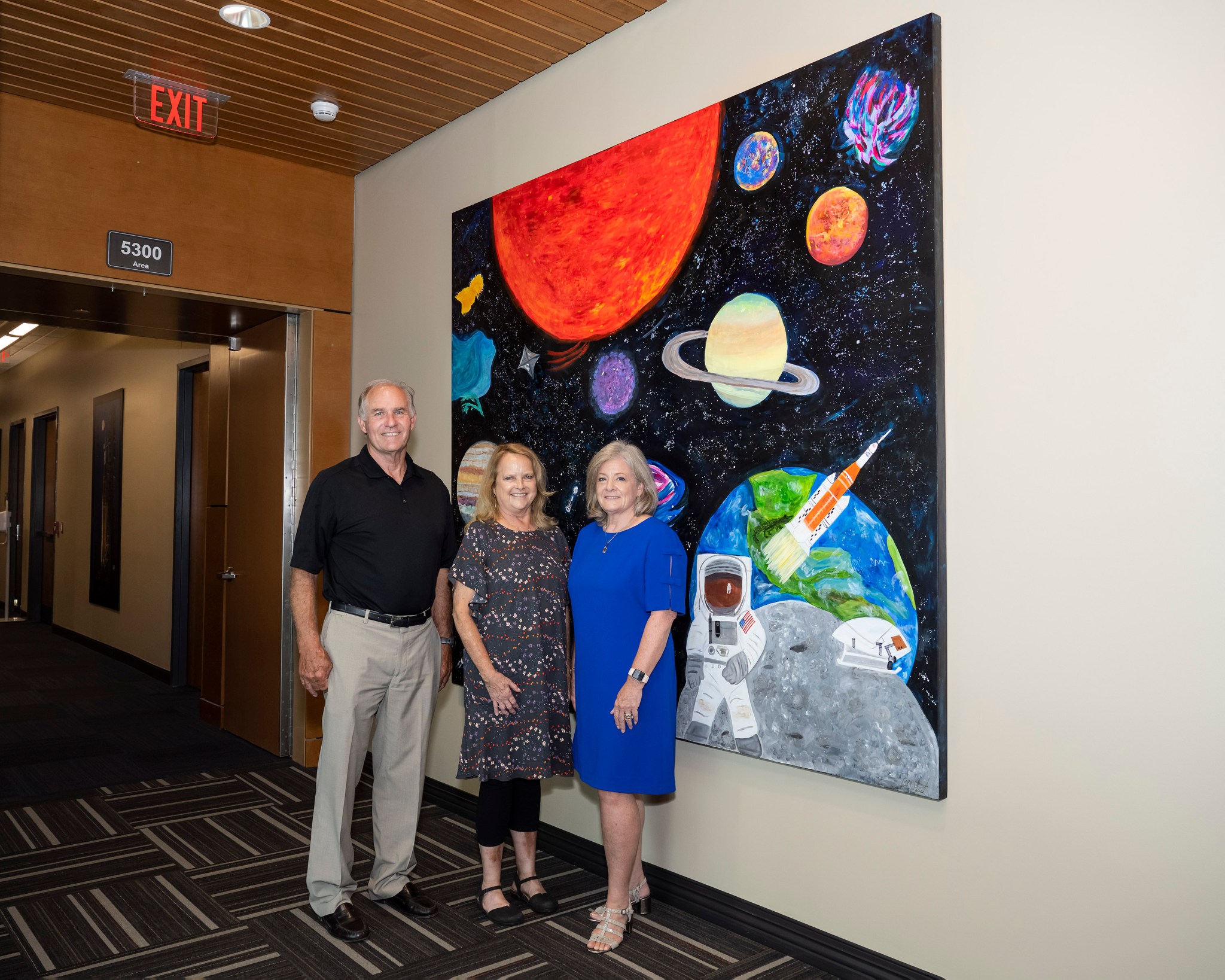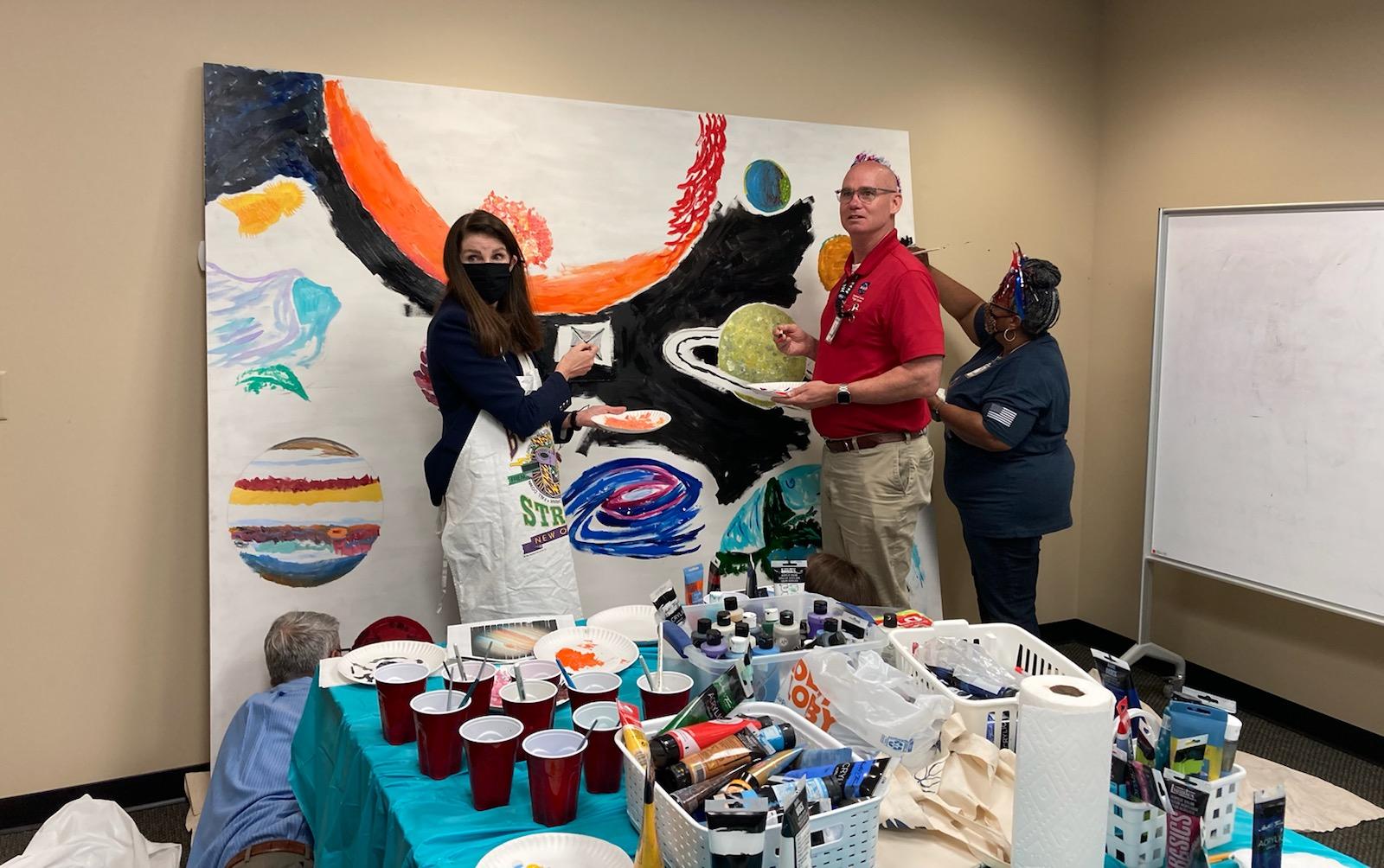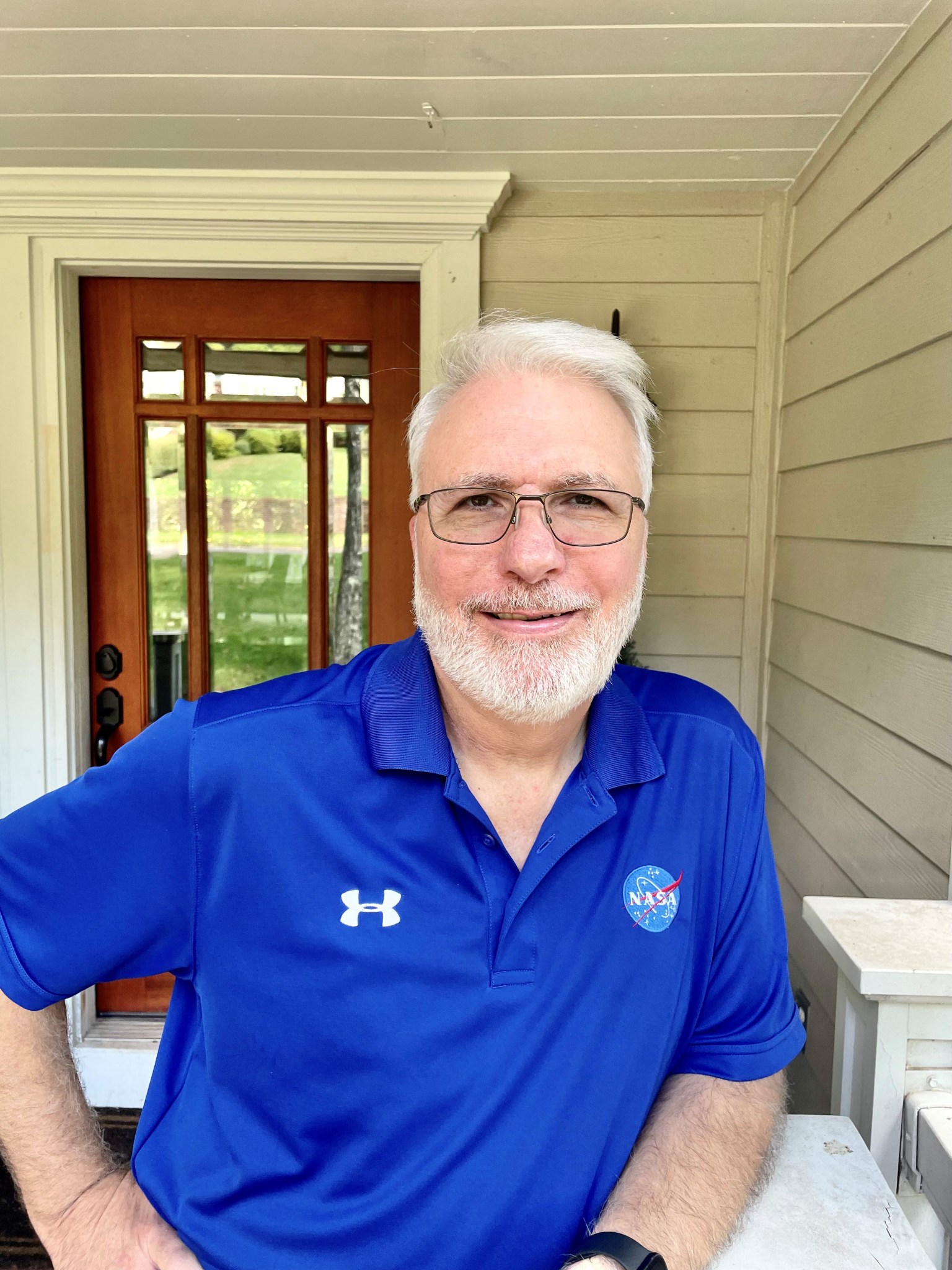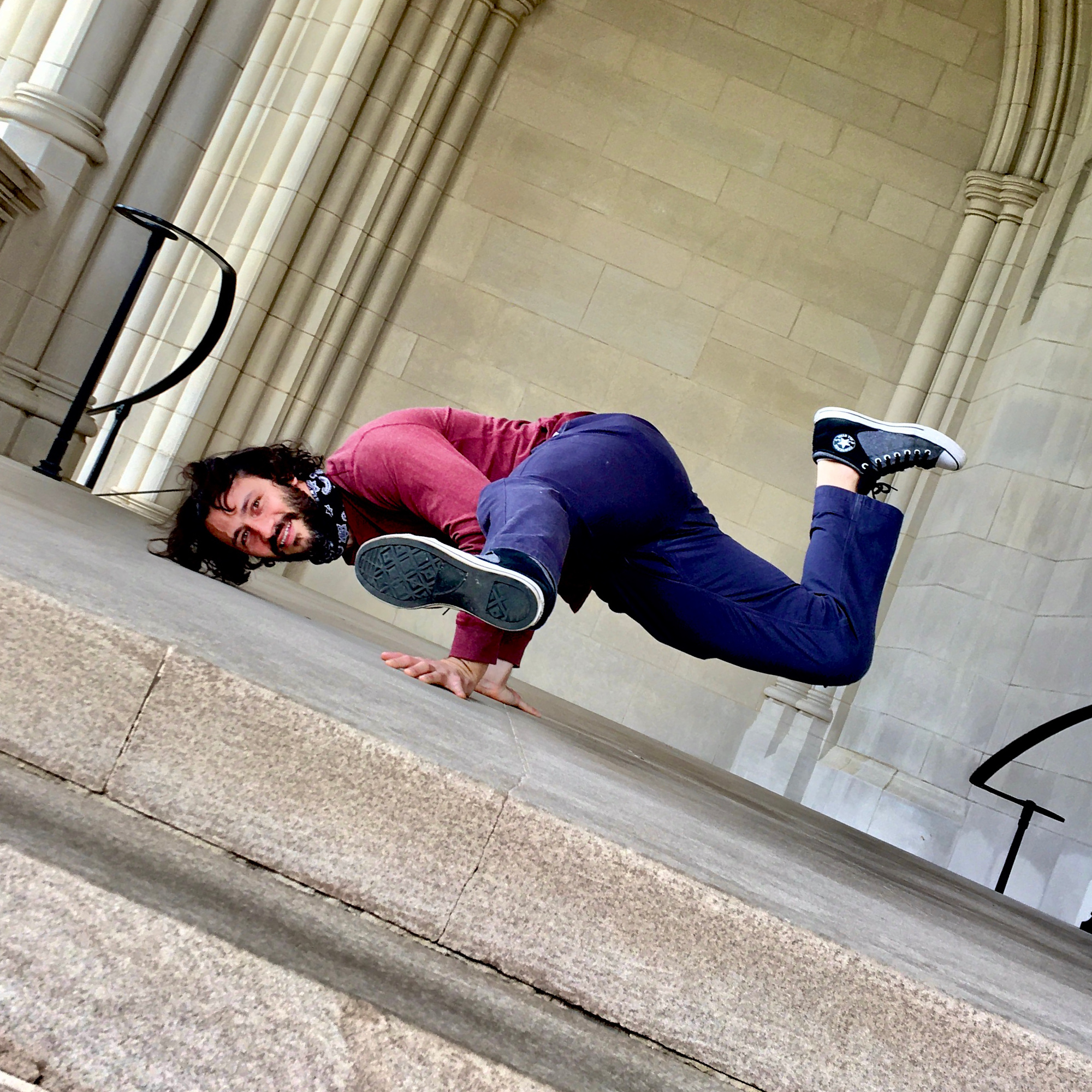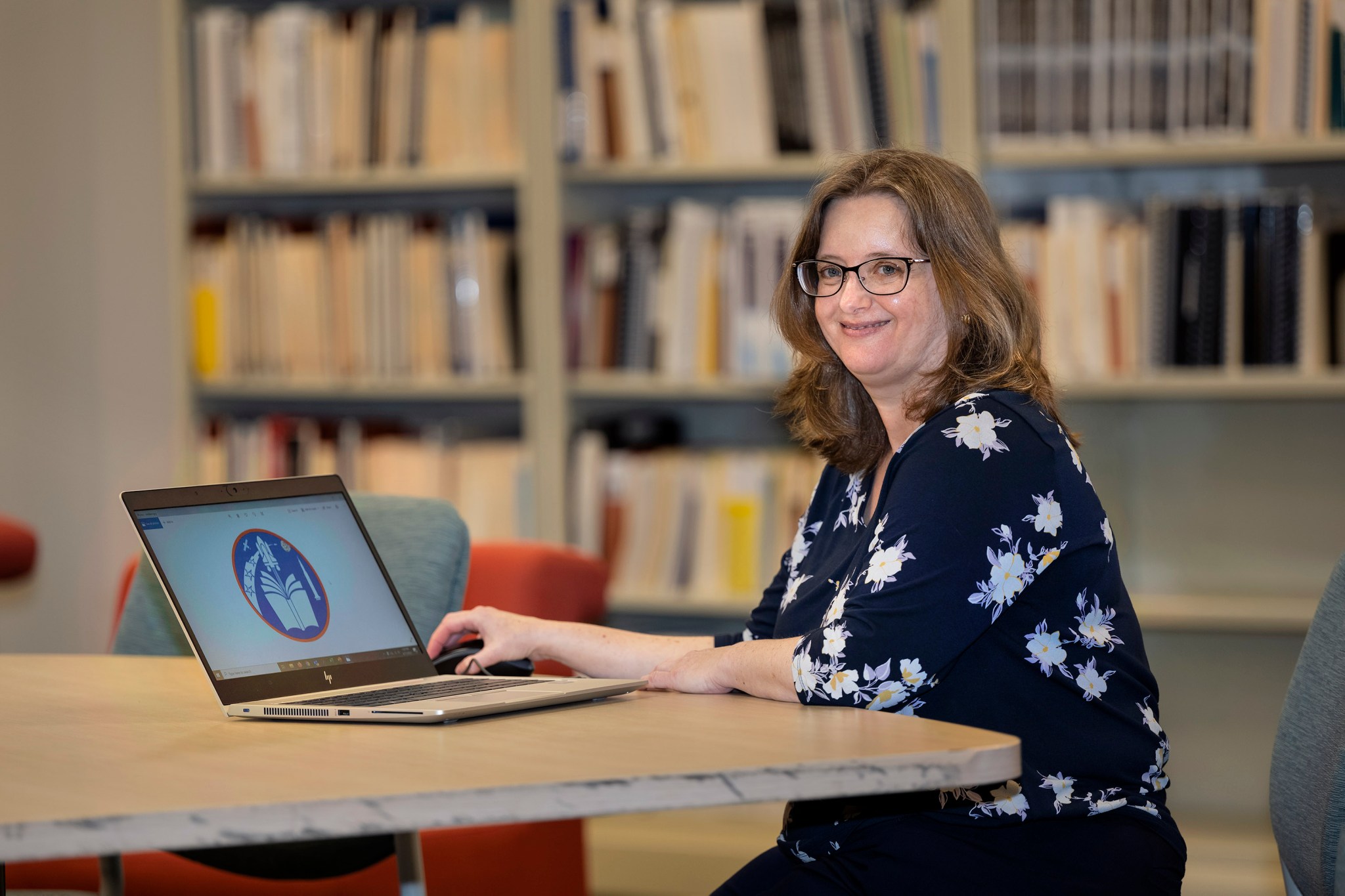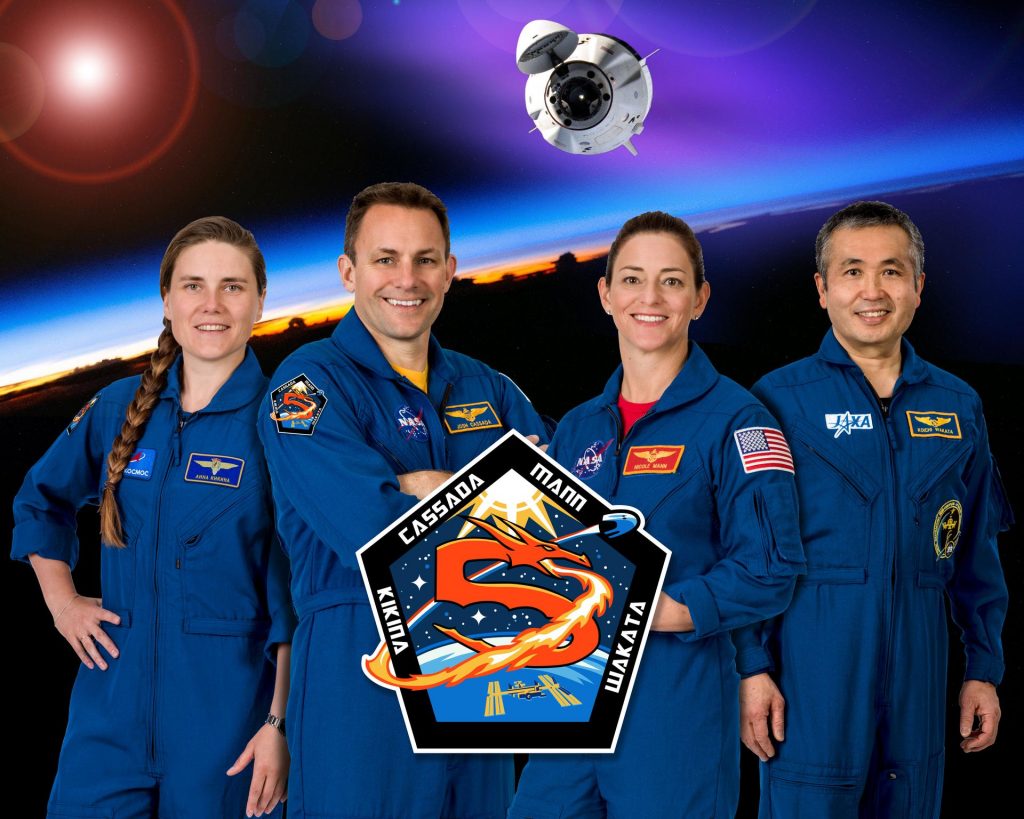In This Week’s Star
- Gallery Spotlights Team Member Photos From Artemis I Launch Event, Rollout
- Michoud Team Members Enjoy Artemis I Launch Party in August
- Astronaut Matthew Dominick Discusses Building Trust During Annual Safety Day; John Smith Receives Golden Eagle Award
- Marshall Leaders Collaborate on Colorful Art Project
- Take 5 with Scott Bellamy
- Kimberly Robinson Guest Speaker for Marshall Association Meeting
- Multitalented Early Career Scientist Mason Quick Thrives on Variety
- New Look, New Logo for NASA’s REDSTAR Data Repository at Marshall
- NASA’s SpaceX Crew-5 Astronauts Meet Their Dragon
Gallery Spotlights Team Member Photos From Artemis I Launch Event, Rollout
Tiffany Lockett, above, has her finger on everything Artemis I during rollout for the Aug. 29 launch attempt, while Brendan O’Connell, below, poses for a photo with the rocket at dusk at NASA’s Kennedy Space Center. View more photos from Marshall Space Flight Center team members here, where you can also send in your own launch photos and videos.
NASA scheduled a cryogenic demonstration test Sept. 21 for Artemis I and has updated its request for a launch opportunity Sept. 27, with a potential backup opportunity of Oct. 2 under review. Check the Artemis I blog for updates. Artemis I is the first integrated flight test of the Space Launch System (SLS) rocket and Orion spacecraft beyond the Moon. Marshall is responsible for the design, development, testing, and manufacturing of the rocket. (NASA)
Michoud Team Members Enjoy Artemis I Launch Party in August
Team members at NASA’s Michoud Assembly Facility participate in an Artemis I launch party Aug. 29. More than 900 employees attended the event in the Hero’s Way presentation area within Building 103. Attendees received NASA, Artemis, and Michoud-themed posters, pins, stickers, and patches. Marshall manages Michoud, where the agency manufactured some of the largest elements of the SLS and Orion crew spacecraft for the Artemis missions. Elements for future Artemis missions are currently in production at Michoud, along with the Orion crew modules and Exploration Upper Stage hardware. (NASA/Michael DeMocker)
Astronaut Matthew Dominick Discusses Building Trust During Annual Safety Day; John Smith Receives Golden Eagle Award
NASA astronaut Matthew Dominick shares stories from his days flying fighter aircraft as a Navy pilot during his keynote address Sept. 20 as part of Marshall Space Flight Center’s annual Safety Day. This year’s Safety Day theme was “Safety at our Core as we Explore.” Safety Day Chairperson Joseph Gaines welcomed the more than 75 Marshall team members gathered in person and those joining the event online. “While the workforce transitions from telework to a hybrid setting, I hope the Marshall team continues to practice safety at work and at home,” Gaines said.
Following a kickoff message from Rae Ann Meyer, associate director of Marshall, Dominick recounted several safety threats he encountered while flying Boeing F/A-19E/F Super Hornets on missions over the Arabian Sea and into Pakistan. Dominick discussed the importance of taking ownership of mistakes, fighting complacency, and investing in colleagues to create safe working environments. “Building trusting relationships has saved my life,” he said. “Be a good teammate, speak up when you see something; show people you are trustworthy by being on time and doing your part. It will help keep us all safe.” Dominick was selected by NASA to join the 2017 astronaut candidate class.
He has since completed the initial astronaut candidate training and is now eligible for a mission assignment. The Colorado native earned a Bachelor of Science in Electrical Engineering from the University of San Diego and a Master of Science degree in Systems Engineering from the Naval Postgraduate School. He graduated from the U.S. Naval Test Pilot School. Dominick has more than 1,600 hours of flight time in 28 aircraft, 400 carrier-arrested landings, and 61 combat missions. In conjunction with Safety Day, Marshall and Michoud team members can participate in the Safety Culture Survey, providing feedback concerning the safety culture with the goal of preventing incidents from occurring. The survey is open through Oct. 14. (NASA/Mick Speer)
John Smith, center, receives the Golden Eagle Award during Safety Day activities Sept. 20 at NASA’s Marshall Space Flight Center. He is joined by, from left, Bill Hill, director of Marshall’s Safety and Mission Assurance Directorate; NASA astronaut Matthew Dominick; Smith’s wife, Gail; and Jeff Haars, vice president and program manager at Jacobs Space Exploration Group. Smith, a Jacobs employee, has supported the Human Factors and Logistics Team at Marshall for more than 15 years. He was recognized for developing high fidelity mockups of Space Launch System (SLS) hardware designs where the human/machine interface is critical, helping NASA visualize how computer designs translate into flight hardware before production begins. Identifying crucial human factors issues helps detect hardware incompatibilities and avoids cost and schedule impacts.
Since 2015, the Golden Eagle Award has been presented quarterly by Marshall’s Mission Success is in Our Hands organization, a safety initiative collaboration between Marshall and Jacobs. The award promotes awareness and appreciation for flight safety, as demonstrated through the connections between employees’ everyday work, the success of NASA and Marshall’s missions, and the safety of NASA astronauts. The award recognizes individuals who have made significant contributions to flight safety and mission assurance above and beyond. Management or peers can nominate any team member for the award here. Honorees are typically recognized at Mission Success is in Our Hands Shared Experiences forums. (NASA/Mick Speer)
Marshall Leaders Collaborate on Colorful Art Project
By Hannah Maginot
A fresh splash of color has brightened the walls of the highest offices at NASA’s Marshall Space Flight Center, thanks to a collaborative art project created by Marshall’s senior leaders.
This summer, more than 50 Marshall leaders painted a large, space-themed canvas as part of a team-building exercise during a senior leadership offsite event. The group included D-Code members, direct reports, deputy direct reports, interns, and administrative assistants. The colorful painting is displayed on the fifth floor of building 4221, adding a bit of whimsy to the lobby at the entrance of the Director’s Suite.
Marshall Director Jody Singer participated in a similar project in a leadership class and knew it would be a good challenge for Marshall’s leaders. Singer hoped to encourage collaboration among team members while also pushing them to think creatively about the future of NASA.
“I really just wanted to set the stage and see what came out of it,” Singer said. “I was pleasantly surprised at all the artistic talent we had in the room.”
Former Marshall team member Steve Cash built the 7-foot-by-8-foot canvas frame. Cash started at Marshall in 1982 and went on to manage Marshall’s Space Shuttle Propulsion Office and serve as director of Safety and Mission Assurance.
Steve’s wife, Pam Cash, a local artist, facilitated the exercise. After Pam sketched out a few images on the canvas in pencil, participants were challenged to pick up a paint brush and fill in the blanks. They were not told which colors to use and were encouraged to let imagination take over.
The result features the Moon and Earth, the Sun, planets, stars, an astronaut, and a handful of NASA projects, including the Space Launch System (SLS) soaring across the canvas. Painters even snuck in quirky details, like an alligator riding on SLS.
Curtis Manning, management intern at Marshall’s Office of the Center Director, said watching the painting come to life reminded him of listening to a symphony.
“Each person was painting their piece, like all the different instruments coming together,” Manning said. “For some, it was just two or three dots and they were done, and other people were really getting into it and painting entire portions of the canvas. We had people reaching over shoulders and laying on the floor. There was a lot of enthusiasm.”
Singer said she hopes this example sparks more team building across Marshall. She also expects future team members to add to the painting as Marshall grows.
“I think it shows trust, having the courage to jump out of your comfort zone and pick up a brush, especially when you know it’s not going to be a Picasso,” Singer said. “But now, when I look at it, I can’t help but smile. I’m really proud of the team and what we created.”
Team members from the facilities department delivered and hung the artwork in mid-August, putting the final touch on a project that was truly a team effort. Singer said the painting has since served as a conversation starter.
“When [NASA Associate Administrator] Bob Cabana was here recently, he saw it and said, ‘Your team did that? Wow, that’s amazing,’ ” Singer said.
It is not lost on Singer that this painting stands out from much of the other formal portraits and historical artwork that hang throughout Marshall’s offices. That is exactly why she believes it belongs.
“We are writing a new chapter in space exploration history. Why not show – in our own way – how Marshall is a critical part of making it happen?” Singer said. “Hopefully the artwork will be hanging there for years to come, and we can take pride in what we have accomplished as a team.”
Maginot, a Media Fusion employee, supports Marshall’s Office of Strategic Analysis & Communications.
Take 5 with Scott Bellamy
By Daniel Boyette
Working on historic space missions is part of the daily routine for Scott Bellamy. He’s a mission manager in the Planetary Missions Program Office at NASA’s Marshall Space Flight Center and currently oversees aspects of the agency’s Double Asteroid Redirection Test, or DART, the world’s first planetary defense test mission.
He was previous mission manager for the Origins, Spectral Interpretation, Resource Identification, Security-Regolith Explorer, or OSIRIS-REx, the first U.S. spacecraft to collect a sample from an asteroid. One of his co-workers manages the Lucy mission, the first visit to Jupiter’s Trojan asteroids, while another managed New Horizons, the first fly-by mission to Pluto.
“Every day in this office is something new and exciting!” Bellamy said.
DART launched in November 2021 and is scheduled to reach Dimorphos, the moonlet of the asteroid Didymos, on Sept. 26. DART will intentionally execute a kinetic impact into Dimorphos to slightly change its motion in space. While the asteroid does not pose any threat to Earth, the DART mission will demonstrate that a spacecraft can autonomously navigate to a kinetic impact on a relatively small asteroid and prove this is a viable technique to deflect an asteroid on a collision course with Earth if one is ever discovered.
Question: How would you describe your job to someone who doesn’t work with the Planetary Missions Program Office?
Bellamy: The Planetary Missions Program Office is responsible for managing all of NASA’s robotic missions to the inner and outer planets, dwarf planets, asteroids, and comets – JPL manages most missions to Mars, except for InSight, which we manage. We also have responsibility for the current robotic missions to the Moon, as well as the still-flying Lunar Reconnaissance Orbiter and previously the Lunar Atmosphere and Dust Environment Explorer mission that intentionally impacted the Moon in April 2014.
The other mission managers and I are the day-to-day interface for the program manager with each project/mission assigned to our office. We track every success, challenge, or issue with each of the project teams for the 19 active missions.
Question: What are your primary responsibilities as the Planetary Missions Program Office mission manager for DART?
Bellamy: As mission managers, we provide insight/oversight on all cost, schedule, and technical developments of assigned missions to provide the program manager and NASA Headquarters the most timely and accurate information possible. This includes overseeing the execution of lifecycle reviews and extends down to weekly status meetings with the projects and our counterparts at headquarters.
Our motto is “Leading by Influence” to focus attention and ensure the projects have ready access to the resources they need. When complications or barriers arise, we reach back, over, or out to broker support or negotiate compromises to maintain progress.
Question: What other projects or missions do you work on/have you worked on?
Bellamy: I’m the mission manager of the Europa Clipper mission launching in October 2024 that will conduct detailed observations of Jupiter’s icy moon Europa, and possibly guide the development of a lander mission to either Europa or Saturn’s icy moon Enceladus. Both moons are believed to have a liquid ocean capable of harboring microbial life.
Prior to Europa Clipper, I managed OSIRIS-REx, which launched in August 2016 and will return the sample to Earth in September 2023. While I did have to hand off OSIRIS-REx for Clipper, the excitement of the Touch-and-Go sample collection event was no less awesome.
Simultaneously with OSIRIS-REx, I managed DART during its development phase, along with NEXT-C (NASA Evolutionary Xenon Thruster-Commercial), which debuted on DART as the primary propulsion system.
Along with those, I was the early mission manager for what is now the Near-Earth Object Surveyor mission. That purpose of that mission is to find potentially hard-to-image asteroids.
Question: Who or what inspired you to pursue an education/career in engineering?
Bellamy: Apollo. I watched Apollo 13 from my grandparents’ couch as it played out on TV. Maybe I watched Neil and Buzz, too, but I honestly can’t remember. Regardless, I was forever enamored. My mother has a paper I wrote when I was around 7 years old, detailing my grand plan: get a degree in engineering, join the Air Force, become a test pilot, and then become an astronaut. Well, I am an engineer, and I did join the Air Force, and now I work at NASA. I had to get glasses before finishing my degree and couldn’t apply for flight school, so …
Question: What do you enjoy doing with your time while away from work?
Bellamy: Lately, it’s studying German using an app. I started during the quarantine months and have a streak of almost 500 days going. My wife and I greatly enjoyed our road trip through the German countryside a few years ago, but being able to order dinner in German would’ve been easier – and more respectful.
My wife and I enjoy traveling. Our goal is to go somewhere new every year on our anniversary. Though, it’s probably good that New Zealand limits immigration, or else we might not come home!
Boyette, an LSINC employee, supports Marshall’s Office of Strategic Analysis & Communications.
Kimberly Robinson Guest Speaker for Marshall Association Meeting
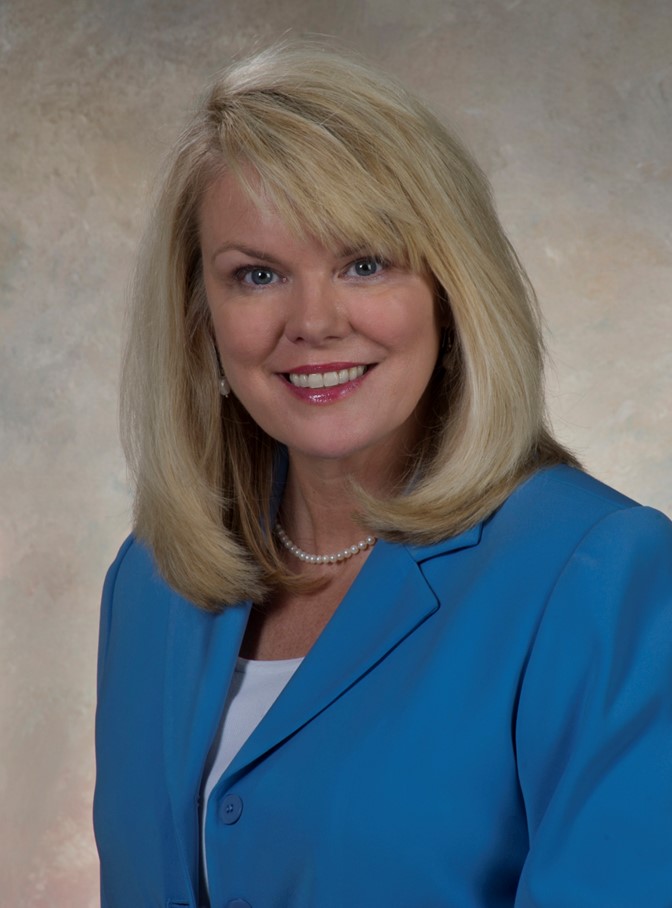
Kimberly Robinson, CEO and executive director of the U.S. Space & Rocket Center, will be the guest speaker for the Marshall Association Speaker Series on Sept. 22. The meeting begins at 1:30 p.m. and can be heard via Teams link here. Prior to assuming her current position at the Space & Rocket Center in February 2021, Robinson served more than three decades at NASA and held several key positions, including utilization manager for Advanced Exploration Systems for the Artemis Program, strategic communications manager and deputy program integration manager for the Space Launch System, and Payload Mission Manager.
Robinson has trained NASA astronauts for science missions aboard the space shuttle and in 2009, while serving as deputy project manager for Ares I-X, her team was awarded Time magazine’s science invention of the year. Her achievements and awards include the agency’s Exceptional Achievement Medal, a Silver Group Achievement Medal, the Astronaut Corps’ Silver Snoopy Award, and a Manned Space Flight Awareness Award.
She holds a doctorate and master’s degree in industrial and systems engineering from the University of Alabama in Huntsville. Robinson will provide the State of The Space and Rocket Center address and share insight on the future of Alabama’s leading tourist attraction and the official visitor center for NASA’s Marshall Space Flight Center. Join or renew your 2022 Marshall Association membership here in support of the association’s scholarship fund, luncheon events, and initiatives. (Credit: U.S. Space & Rocket Center)
Multitalented Early Career Scientist Mason Quick Thrives on Variety
(This is one in a series of profiles on early career scientists in the Earth Science Branch at NASA’s Marshall Space Flight Center.)
By Dauna Coulter
Mason Quick has always been science-oriented. When he learned in elementary school that the Sun was a star, he was hooked. As he grew older, he was drawn to astronomy, but later changed his mind.
“I saw astronomy as the final frontier, but then I realized I couldn’t personally experience it, and I wanted to study something more tangible,” Quick said.
After pursuing astronomy as an undergraduate, he earned a doctorate in atmospheric sciences from the University of Arizona in 2014. Ironically, he now specializes in something less than tangible: lightning.
This 36-year-old atmospheric physicist holds a research scientist position at NASA’s Marshall Space Flight Center, where he manages lightning sensor systems, designs new sensor technology, and analyzes lightning data.
Mason is also an athlete.
“I used to play rugby and soccer,” Quick said. “Now, I play capoeira, an Afro-Brazilian martial art that’s a mix of kicks, fluid movements, and inversions with elements of music and dance. I learned it in Arizona, and we have a group here in Huntsville, too.”
And add musician to his talents.
“I played trumpet in eighth grade,” he said. “One day I picked up a digeridoo, an Australian Aborigine instrument, and found I could play it too.”
He admits that he thrives on variety and has this to say about conformity: “I believe in being yourself. You don’t have to conform to the norm.”
Quick said he needs to work on improving many things in himself and notes that “time management and focus” are most prominent among them.
This Renaissance man is currently designing a new high-resolution lightning imager – the CubeSat Lightning Imaging and Detection Experiment (CLIDE).
“It detects not only the bright flashes, but also the small, faint lightning flashes that hold vital clues to better understanding and monitoring extreme weather,” Quick said. “I want to see whether we can push the technology forward, expand applications of lightning science, and keep progressing into new domains, like lightning on other planets.”
In the past, he led the development of the Fly’s Eye GLM Simulator, a multi-spectral array of radiometers for studying the optical emission from lightning. He recently upgraded that sensor for a July 23 flight campaign to observe terrestrial gamma ray flashes (TGFs) and study their optical, electric field, and high energy particle emissions.
Although TGFs are quite brief (1-2 milliseconds), they appear to be the most energetic events on Earth. They belch destructive gamma-rays packing over 10 million times the energy of visible light photons – enough punch to penetrate several inches of lead.
Asked what he is most proud of, Quick said, “I don’t carry a lot of pride. I owe a lot to having several great mentors: my parents especially, and also some great teachers, coaches, and grad school advisors. And I realize there is so much more to do. But I guess I am proud that I can build high quality cornhole boards!”
Coulter, a Media Fusion employee, supports Marshall’s Office of Strategic Analysis & Communications.
New Look, New Logo for NASA’s REDSTAR Data Repository at Marshall
By Rick Smith
The REDSTAR data repository maintained at NASA’s Marshall Space Flight Center is getting a facelift – and a new home online.
Formally known as the Resource Data Storage And Retrieval Analysis Center, REDSTAR includes more than 43,000 documents – historical analyses, trade studies, cost reports, and much more – dating back to the Mercury and Gemini programs. Established at Marshall in 1971, the repository serves as a primary NASA archive of cost, programmatic, and technical data and documentation for engineers, scientists, and support teams across the agency.
The Program Planning and Control Office, part of Marshall’s Office of Strategic Analysis & Communications maintains REDSTAR, with contributions from organizations and personnel across the agency.
More than 17,000 documents in REDSTAR’s collection have been digitized and tagged for electronic access, searchable by a variety of mission and program types: aircraft, launch vehicles, lunar, and planetary missions, CubeSats, payloads, boosters and motors, robotic science missions, and many more. Search results may be filtered by document author, publication date, major and minor keywords, or company of origin.
Users can request access to the archive through the NAMS system and browse available content via its new landing page on Inside Marshall.
Andy Prince, manager of the Program Planning and Control Office, said identifying REDSTAR as simply a library doesn’t capture the breadth of its value.
“The nature of libraries has evolved, and NASA is evolving its historical archives as well,” he said. “REDSTAR has become a foundational resource for the programmatic analysis we do in the program planning and control community, integrating earned value management, cost estimating and analysis, and numerous other disciplines.”
The repository has evolved to serve a much broader community as well, said REDSTAR manager Melissa Roberts. “We assist engineers, technologists, and support teams across Marshall, NASA, and its partners – anyone who needs to research missions or historical NASA data,” she said.
And if the information being sought isn’t already part of REDSTAR, Roberts can help source and obtain it. She routinely consults other archivists and librarians across NASA and its partners to track down unique data requests and add them to the repository.
She also can help serve the broader aerospace community. In 2019, for example, the Smithsonian Air and Space Museum in Washington needed to move its Skylab exhibit to undertake a major site renovation – but no one knew how to retract the orbiter’s large solar arrays. Notified by NASA Headquarters, Roberts checked REDSTAR, and with assistance from Jordan Whetstone, archivist in the Marshall History Office, sent the museum a digitized how-to manual for manipulating the solar panels.
Roberts continues to acquire new content and new data collections regularly. She and Prince encourage mission personnel to assess their documentation as projects are concluded and missions flown. They also encourage team members preparing for retirement to get in touch.
“If you think you might have historical program data worth saving for posterity, reach out to us,” Prince said. “We’re always happy to add it to the archive, to help better inform the next generation of space pioneers.”
To learn more, email Roberts or visit the REDSTAR Analysis Center in Building 4494.
Smith, a Manufacturing Technical Solutions employee, supports Marshall’s Office of Strategic Analysis & Communications.
NASA’s SpaceX Crew-5 Astronauts Meet Their Dragon
By Jim Cawley and Lance D. Davis
The astronauts who will fly aboard NASA’s SpaceX Crew-5 mission next month are now well-acquainted with their ride to space. Following a successful crew equipment interface testing at NASA’s Kennedy Space Center, crew members are ready for their trip to the International Space Station for a science expedition mission.
NASA astronauts Nicole Mann, commander; Josh Cassada, pilot; and mission specialists Koichi Wakata, of the Japan Aerospace Exploration Agency, and Roscosmos cosmonaut Anna Kikina will lift off aboard SpaceX’s Dragon spacecraft – on the company’s Falcon 9 rocket – from Launch Complex 39A at Kennedy. Liftoff is targeted for no earlier than Oct. 3. As part of the agency’s Commercial Crew Program (CCP), Crew-5 marks the sixth human spaceflight mission on SpaceX’s Dragon spacecraft and the fifth crew rotation mission to the space station since 2020.
The testing allows crew members to familiarize themselves with the launch-day timeline and the Dragon interior in a close-to-flight configuration. As part of the testing, astronauts don their flight suits, perform a suited ingress into the vehicle, conduct suit leak checks, and complete communication checkouts.
While inside the vehicle, the crew also listens to the Dragon spacecraft’s fans and pumps to prepare them for the sounds they can expect to hear on launch day. Crew members take additional time to familiarize themselves with the interior of the Dragon before egressing the vehicle, which marks the test conclusion.
The crew also has undergone mission-specific training at NASA’s Johnson Space Center. This unique 18-month training program featured activities such as studying and participating in extravehicular activities; Russian language; robotics; T-38 jet flying; spacesuit training; spacecraft training; and physical, tool, and science training.
Crew-5 will fly to the space station in SpaceX’s Dragon Endurance, which previously flew the agency’s Crew-3 mission to and from the orbiting laboratory.
The CCP launch vehicle on-console mission support team at NASA’s Marshall Space Flight Center continues contributing to commercial crew missions, including the Crew-5 mission.
Consisting of about 80 people supporting the CCP office, Engineering, and Safety Mission Assurance, the Marshall team members provide management support as well as engineering expertise in propulsion, valves and pyrotechnics, natural environments, and vehicle structures, among others.
“Our team’s technical expertise and dedication have been valuable assets going into each of our CCP flights and missions,” said Deborah Crane, CCP launch vehicle chief engineer. “Crew-5 will be the CCP’s sixth crewed flight since Demo-2 in May of 2020, and the support of our NASA and Marshall teams has been – and continues to be – exemplary!”
Marshall’s team is integral to the certification and readiness of the Crew-5 flight, with support mostly in the launch vehicle area, and some to Spacecraft (Dragon) propulsion and integrated performance. The team has followed this hardware closely from build to test, and through integration.
When hardware was damaged during the first stage’s transportation from SpaceX’s production factory to its test facility, Marshall’s team worked closely with SpaceX to assess the damage, developing a plan to repair and evaluate its use for Crew-5. That stage is now fully repaired and ready to support the flight.
The team’s assessments and inputs directly support the certification of flight readiness for the Crew-5 mission, along with the CCP Program Flight Readiness Review on Sept. 21 and Agency Flight Readiness Review on Sept. 26. Marshall’s mission support team will support the next commercial crew launch from the Huntsville Operations Support Center at Marshall and on site at Kennedy.
“Every mission is different, with its own unique challenges, and I’m very proud of how our team approaches those challenges, with focus, determination, and a shared commitment to the success and safety of the mission,” said Lisa McCollum, manager of Marshall’s Commercial Crew Program support team. “We are ready to support the Crew-5 launch!”
Follow the commercial crew blog for the latest information on Crew-5 progress and flight readiness as reviews and milestones continue. NASA and its partners will host a media event in the coming weeks to discuss more about Crew-5 progress.
Details about the mission and NASA’s CCP can be found by following the Crew-5 blog, the commercial crew blog, @commercial_crew on Twitter, and commercial crew on Facebook.
Jim Cawley is public affairs writer at Kennedy, and Lance D. Davis is a public affairs officer in Marshall’s Office of Communications.



























